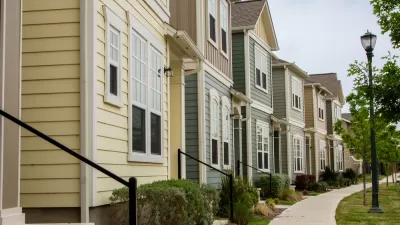New research shows that reducing lot size requirements helped create thousands of new homes.

A new study from the University of Texas at Austin, sponsored by The Pew Charitable Trusts, analyzes how reducing minimum lot size requirements in Houston, Texas impacted the city’s housing stock.
As a brief from Pew explains, “Rules that allow only detached houses on large lots are often at the center of debates about zoning, and this study helps to shed light on how land-use reform affects urban residential neighborhoods.”
The study’s findings “suggest that SF2TH conversions helped to increase the number of available homes—and therefore households—in high-demand areas without driving out existing residents, belying a claim commonly made by opponents of land-use reform that new development in dense urban communities would lead to gentrification.”
Houston reduced its lot size requirement from 5,000 square feet to 3,500 square feet in 1998, expanding that ordinance to almost the entire city in 2013, leading to a rise in the construction of smaller, more affordable town houses.
The study concludes that “Land-use reforms can spur housing development” and “often have only incremental impacts on the physical character of residential neighborhoods.” Furthermore, in Houston, “Adding more housing did not displace residents.” The study found that “Ultimately, allowing enough housing for everyone enabled affordability and reduced displacement pressures.”
FULL STORY: Lot-Size Reform Unlocks Affordable Homeownership in Houston

Planetizen Federal Action Tracker
A weekly monitor of how Trump’s orders and actions are impacting planners and planning in America.

Maui's Vacation Rental Debate Turns Ugly
Verbal attacks, misinformation campaigns and fistfights plague a high-stakes debate to convert thousands of vacation rentals into long-term housing.

San Francisco Suspends Traffic Calming Amidst Record Deaths
Citing “a challenging fiscal landscape,” the city will cease the program on the heels of 42 traffic deaths, including 24 pedestrians.

Defunct Pittsburgh Power Plant to Become Residential Tower
A decommissioned steam heat plant will be redeveloped into almost 100 affordable housing units.

Trump Prompts Restructuring of Transportation Research Board in “Unprecedented Overreach”
The TRB has eliminated more than half of its committees including those focused on climate, equity, and cities.

Amtrak Rolls Out New Orleans to Alabama “Mardi Gras” Train
The new service will operate morning and evening departures between Mobile and New Orleans.
Urban Design for Planners 1: Software Tools
This six-course series explores essential urban design concepts using open source software and equips planners with the tools they need to participate fully in the urban design process.
Planning for Universal Design
Learn the tools for implementing Universal Design in planning regulations.
Heyer Gruel & Associates PA
JM Goldson LLC
Custer County Colorado
City of Camden Redevelopment Agency
City of Astoria
Transportation Research & Education Center (TREC) at Portland State University
Jefferson Parish Government
Camden Redevelopment Agency
City of Claremont





























